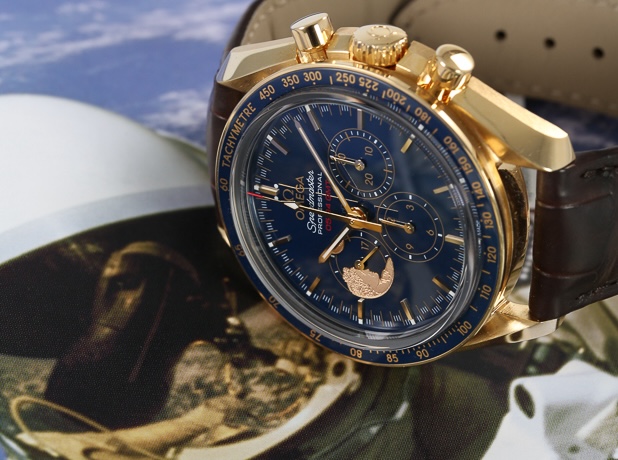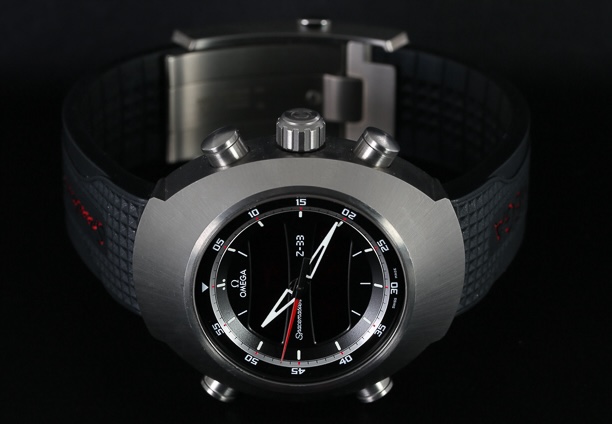It was a truly historic moment; one small step for man, one giant leap for mankind. These immortal words uttered by Commander Neil Armstrong as he took the very first steps onto the moon’s surface on the 20th July 1969 celebrated what was one of humanity’s greatest achievements.
Along with Armstrong (and Command Module Pilot Michael Collins) was Buzz Aldrin, the second person to set foot on our satellite’s surface. While he may have only been the second man on the moon, Aldrin did end up having his own unique claim to fame — the person who wore the first watch on the moon — the OMEGA Speedmaster (or Speedy as it’s also known).
As you’d expect, OMEGA subsequently made a huge deal out of this, and has since released several iterations of this legendary timepiece under the “Moonwatch” moniker. But which exact model was the OMEGA watch that went to the moon? Join us as we find out.
Exploring Early OMEGA Speedmasters
This may sound surprising, but the origin of the OMEGA Speedmaster actually predates the Apollo Program by six years. Long before it became the first watch on the moon, the Speedy was launched in 1959 with the purpose of serving as a chronograph for racing and other sports.
The first iteration of the Speedmaster was made purely from stainless steel and had a black dial. It was 39mm in diameter and boasted water resistance of 50 metres.
Prior to becoming the OMEGA watch that went to the moon, the Speedy earned another accolade. In 1962, the CK 2998 became the first timepiece from the manufacturer to enter space. Unlike the later versions, however, this was not an official partner of NASA. Instead, it was astronaut Walter Schirra’s personal wristwatch that accompanied him on the Sigma 7 mission of Mercury.
The story goes that after this mission, Schirra and his fellow crewmen suggested to NASA that it should partner with a watchmaker and select an official timepiece to accompany astronauts on future missions.
A Brief History of OMEGA & the Moon Landing
Before we delve into the story of the OMEGA watch that went to the moon, it’s important to understand how everything started. Why did such an epic undertaking take place, and how did the Speedy end up on the astronauts’ wrists?
How it All Began
The history of the Apollo Program dates all the way back to 1963, when it was launched as a follow-up to Project Mercury — the first time man went into space. Apollo’s mission was simple: land humans on the moon and bring them safely back again.

Although the idea was first conceived by President Dwight D. Eisenhower’s administration, the required funding was secured by his successor, John F. Kennedy, whose campaign promise was to win the so-called “space race” against the USSR. Some 10 missions were launched within the subsequent six years, with various degrees of success. Apollo 7 was the first to orbit the Earth, while Apollo 8 became the first crewed spacecraft to orbit a celestial body other than our home planet. Missions 7-11 also gave NASA the opportunity to test vital instruments and components to ensure everything would work as intended.
The Watch Trials
It wasn’t just NASA’s own technology that needed to be tested, as the agency also required a reliable timepiece that astronauts could use while in space. So, in 1964, NASA asked various watchmakers to take part in a series of trials to determine which model would become the official partner of the Apollo Program.
Just four companies opted to put themselves forward; Rolex, Longines-Wittnauer, Hamilton, and of course OMEGA. After a series of arduous tests, only OMEGA’s chronograph was deemed good enough — and so, a legend was born.
Which OMEGA Watch Went to the Moon?
Out of the many, many Omega Speedmasters that carry the name “Moonwatch”, only three references actually landed on our satellite’s surface. The triumphant trio are:
OMEGA Speedmaster 105.012
The original moonwatch, the Speedmaster Professional 105.012 was the timepiece worn by Buzz Aldrin on that monumental day in 1969. Measuring 42mm in diameter, with a symmetrical case design this timepiece certainly cemented itself in history.
Incidentally, Neil Armstrong is reported to have left his own Speedmaster (also a 105.012) onboard the lunar module to act as back up for a malfunctioning electronic timer. Buzz Aldrin’s own Speedy ended up going missing while in transit to the Smithsonian Museum in the early 1970s and has still not been found.
OMEGA Speedmaster 145.012
Released in 1967 and 1968, the OMEGA Speedmaster 145.012 was actually a pre-Moonwatch that had been used by several astronauts. Indeed, it was the most-used timepiece during NASA missions, but had never touched down on the moon’s surface.
That all changed on the 15th February 1971, when Alan Shepard wore one as part of the Apollo 14 mission. The model was a slight upgrade to the 105.012, boasting taller caps and screwed-in pushers.
OMEGA Speedmaster 105.003
The final OMEGA watch that went to the moon, the 105.003 has a similar story to the 145.012, since it had also been into space prior to landing on our satellite and is classified as a “pre-Moonwatch”, since it was produced before 1969. It was worn by astronaut Ed White during a spacewalk in 1964, before Gene Cernan took it a step further in 1972 as part of the Apollo 17 mission.
Landing on the moon isn’t the 105.003’s only claim to fame, however. This was the very model that kickstarted the entire relationship between OMEGA and the Apollo program. It was the timepiece that was qualified by NASA in 1964, and approved as an official partner in 1965. The watch had a slimmer profile than its successors, with straight lugs and no crown guard.
The Modern Moonwatch
Given its monumental achievement, it’s easy to forgive OMEGA for playing up to the “Moonwatch” moniker ever since the timepiece landed on our satellite. Over the years, there have been several iterations, including some with skeleton dials and others even adorned with images of Snoopy.

Each timepiece which bears the name Speedmaster Professional is technically known as a Moonwatch, given that they are direct descendants of the 105.012. However, if you’re only looking for ones which have landed on the surface of our satellite, you’re limited to just three legendary models — for now, at least.
A Lasting Relationship
OMEGA’s relationship with NASA has continued far beyond the Apollo program. The Speedy is still the space agency’s preferred mechanical watch, used as an analogue back up to its digital equipment. There’s probably quite a lot of sentiment attached to this, with the timepiece almost acting like a good luck charm for astronauts.
In the next year or so, NASA’s Artemis program will attempt to get humans on our satellite once again. If this happens, it’s highly likely we’ll be able to talk about a fourth OMEGA watch that went to the moon in the not-too-distant future.
Not only that, but the space agency is also looking at a mission to Mars in the 2030s. It’s even rumoured that another variant of the Speedmaster, a “Mars Watch”, could be on the cards to commemorate the journey to the red planet. All of this ensures the Speedy will not quite be done with space travel just yet.
A Stellar Collection of Speedmasters at Blowers Jewellers
If you’re looking to own an OMEGA watch that went to the moon, or any member of the legendary Speedmaster collection, you luckily won’t have to go as far as outer space to achieve it. Blowers Jewellers has a wide range of Speedys for you to choose from, alongside many other collections from the watchmaker’s catalogue.
For over 50 years, we’ve established a glittering reputation for both the quality of our products and our service. Each and every timepiece we stock has been hand-chosen by our experts, so you can be totally confident you’re only getting the best. We’ll even support you at every stage of the purchasing process, such as recommending what we believe is the perfect watch to suit your style.
Interested in something else other than an OMEGA? No problem! We also stock beautiful timepieces from the world’s most luxurious brands, such as Rolex, Audemars Piguet, Panerai, Tudor, and Patek Philippe. Whatever you’re looking for, you’re sure to find it with us. For more information about how Blowers Jewellers can help you find the watch of your dreams, get in touch with our team today.
